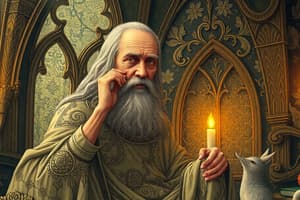Podcast
Questions and Answers
What are the two main categories of biologic aging theories?
What are the two main categories of biologic aging theories?
- Psychological Theories
- Nonstochastic Theories
- Both A and B (correct)
- Stochastic Theories
What does the term 'gerontology' refer to?
What does the term 'gerontology' refer to?
The study of aging
The process of growing older begins at ______.
The process of growing older begins at ______.
birth
Which theory explains biological aging as resulting from complex predetermined factors?
Which theory explains biological aging as resulting from complex predetermined factors?
What is the Wear and Tear Theory focused on?
What is the Wear and Tear Theory focused on?
Stochastic theories view aging as resulting from random assaults from the internal and external environment.
Stochastic theories view aging as resulting from random assaults from the internal and external environment.
Which of the following is NOT a nonstochastic theory of biologic aging?
Which of the following is NOT a nonstochastic theory of biologic aging?
What role do gerontological nurses play in understanding aging?
What role do gerontological nurses play in understanding aging?
The ______ Theory proposes that aging is due to random damage to biological structures.
The ______ Theory proposes that aging is due to random damage to biological structures.
Flashcards
Aging
Aging
The natural process of growing older, starting from birth. It encompasses physical, mental, and social changes over time.
Nonstochastic Theories of Aging
Nonstochastic Theories of Aging
Theories of aging that suggest the process is predetermined and influenced by genes and programmed biological processes.
Stochastic Theories of Aging
Stochastic Theories of Aging
Theories suggesting aging occurs due to random damage accumulation from environmental factors and internal processes.
Cross-Linking Theory
Cross-Linking Theory
Signup and view all the flashcards
Wear and Tear Theory
Wear and Tear Theory
Signup and view all the flashcards
Free Radicals and Lipofuscin Theory
Free Radicals and Lipofuscin Theory
Signup and view all the flashcards
Evolutionary Theories of Aging
Evolutionary Theories of Aging
Signup and view all the flashcards
Disengagement Theory
Disengagement Theory
Signup and view all the flashcards
Activity Theory
Activity Theory
Signup and view all the flashcards
Study Notes
Introduction to Theories of Aging
- Aging is a complex process studied across various disciplines over recent decades.
- Multiple theories explain aging as no single theory is universally accepted.
- Understanding aging can aid in delaying its effects and enhancing lifespan.
- Gerontological nurses can utilize aging theories to improve health outcomes for all age groups, especially older adults.
Major Theories of Aging
- Biological Theories encompass both stochastic and nonstochastic explanations.
- Sociological Theories include models like Disengagement Theory, Activity Theory, and more.
- Psychological Theories address aspects such as Developmental Tasks and Gerotranscendence.
- Nursing theories of aging focus on functional consequences, thriving, and successful aging.
Terminologies
- Aging: The progressive process of growing older, beginning at birth.
- Nonstochastic Theories: Suggest aging results from predetermined biological processes.
- Biologic Aging: Loss of function over time, influenced by genetic, environmental, and lifestyle factors.
- Stochastic Theories: Propose aging results from random environmental assaults.
Categories of Biological Aging Theories
- Stochastic Theories:
- Include frameworks that relate aging to random damage accumulation.
- Nonstochastic Theories:
- Emphasize programmed biological processes and genetic influences.
Stochastic Theories of Biological Aging
- Cross-Linking Theory: Proposes that aging results from chemical and radiation exposure causing cross-links among cellular components, impairing function.
- Wear and Tear Theory: Attributes aging to cumulative stresses and injuries from normal bodily functions, likening the body to a machine.
- Free Radicals and Lipofuscin Theories: Suggest that free radicals cause oxidative damage, linked to diseases such as cancer and atherosclerosis.
- Evolutionary Theories: Focus on inherited traits that may not favor aging and survival in a competitive environment over generations.
Studying That Suits You
Use AI to generate personalized quizzes and flashcards to suit your learning preferences.
Description
Explore the various theories that explain the process of aging. This chapter delves into the intersections of different disciplines that contribute to our understanding of aging and discusses potential ways to delay it. Join us in examining the scientific perspectives on why aging occurs and its implications.




